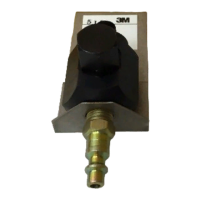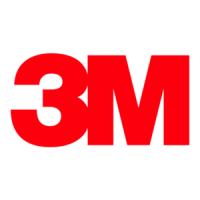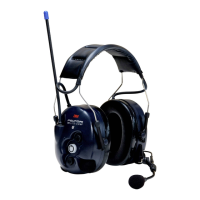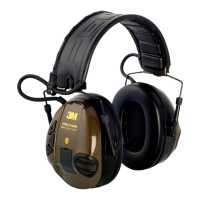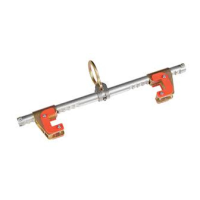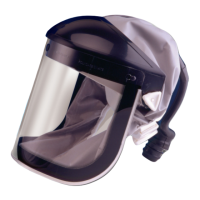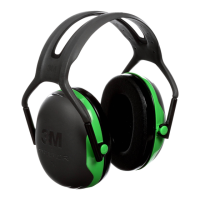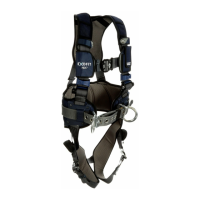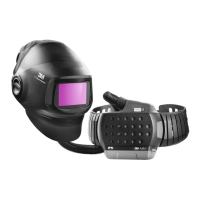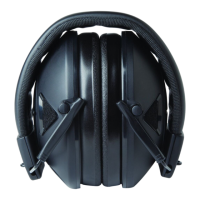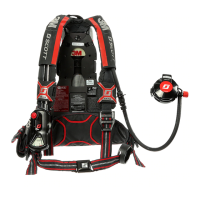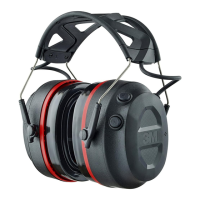4
Attenuation tables
Explanation of attenuation tables: research suggests that
users may receive less noise reduction than indicated by the
attenuation value(s) on the packaging, due to variation in fit,
fitting skill, and motivation of the user. Refer to your
applicable regulations for guidance on how to adjust label
values and estimate attenuation. In addition, 3M strongly
recommends fit testing of hearing protectors.
European Standards EN 352-1:2002, EN 352-6:2002 and
EN 352-8:2008
f (Hz) = test frequency
Mf: Mean attenuation (dB)
Sf: Standard deviation (dB)
APV: Assumed Protection Value (dB)
Intended use
The 3M™ WORKTUNES™ CONNECT earmuffs are
designed to help reduce exposure to hazardous noise levels
and loud sounds.
Product features
The user must determine the overall suitability of this product
for the intended application, taking into account any hazards
other than noise for which this product is tested, and CE
approved.
Important
Please read, understand, and follow all safety information in
these instructions prior to use. Retain these instructions for
future reference. For additional information or any questions,
contact 3M Technical Services (contact information listed on
the last page).
^
Warning
Always be sure that the complete product is:
- Suitable for the application;
- Fitted correctly
- Worn during all period of exposure;
- Replaced when necessary.
^
Particular attention should be given to safety
instruction where indicated
- Failure to follow all instructions on the use of this personal
protection product may adversely affect the wearer’s health,
lead to injury and/or permanent hearing loss.
- Misuse or failure to wear hearing protectors at all times that
you are exposed to noise may result in hearing loss or injury.
- Proper selection, training, use and appropriate
maintenance are essential for the product to help protect the
wearer from noise hazards.
- This product may be adversely affected by certain chemical
substances.
- Contact 3M for additional information (contact information
listed on the last page).
- Leave the area immediately if the hearing protector
becomes damaged.
- The fitting of hygiene covers to the cushions may affect the
acoustic performance of the earmuffs.
- Do not disassemble, modify, or service this device. The unit
contains no user serviceable parts.
- Earmuffs, and in particular cushions, may deteriorate with
use and should be examined at frequent intervals for
cracking and leakage. Replace as needed.
- The acoustic seal may be adversely affected by wearing
other equipment, such as spectacles, respirators, etc. This
may reduce attenuation. If in doubt, contact your safety
officer or 3M.
- For best protection, the ear cushions should seal firmly
against your head. Anything that interferes with the seal such
as long hair (pull back to the extent possible), thick or poorly
fitting eyeglass temples, pencils or caps will lessen the
protection.
- When worn, hearing protectors reduce ambient sounds
which may affect warning signals and vital communication.
Always ensure that you select the right product to match the
working environment so that vital communication and
emergency sounds remain audible.
- This earmuff is provided with electrical audio input. The
wearer should check correct operation before use. If
distortion or failure is detected, the wearer should refer to
manufacturer’s advice. Warning: The output of the electrical
audio circuit of this hearing protector may exceed the daily
limit sound level.
- This hearing protector provides an entertainment audio
facility Other than for broadcast signal receivers,the range of
input signal levels for which this limitation is maintained <300
mV. The audibility of warning signals at a specific workplace
maybe impaired while using the entertainment facility.
To reduce the risks associated with hazardous voltage and
fire:
- Never use this product, or charge/replace batteries, in an
explosive environment.
- Charging temperature range: 0°C to +45°C.
- Only charge using a 3rd party certified equipment (such as
UL, Intertek, etc.).
Audio input level
The audio level in the hearing protector is dependent on the
audio input level. To prevent harmful noise levels, the
hearing protector audio level is limited to 82 dB(A) when
connected to a Personal Music Player (PMP). If the hearing
protector is connected to a PMP or other device with a very
high output level, it is the user’s responsibility to set the
audio input level to a safe level. The maximum permitted
audio input level for 8 hours of usage time, compressed
speech and music is 2.12 V.
Fitting instructions
Prior to fitting, inspect the product to ensure it is not
damaged.
If this is discovered, dispose immediately and obtain a new
pair.
Brush excess hair aside and remove any ear jewelry that
may affect acoustic seal before attempting to fit the hearing
protector.
1. Extend headband to maximum “open” position and place
the cups over the ears with the headband passing over the
head.
2. Settle the headband in position on the head while
adjusting the height of the ear cups until they feel
comfortable and the headband rests on top of the head to
support the muffs. The ear cushions should be a snug fit
against the head.
3. Adjust the headband and the ear cups to ensure an
effective noise seal.
Checking fit
When earmuffs are correctly worn, your own voice should
sound hollow and sounds around you should not sound as
loud as before wearing the earmuffs. For optimum noise
reduction, the cushion should form a snug fit against the
head, with no interference of the seal by any objects e.g.
respirator headbands or spectacles arms. The cups should
completely enclose the ears. If you are unable to fit these
earmuffs correctly and comfortably, contact your safety
officer or 3M for further advice.
Cleaning and maintenance
1. At the end of each shift, the cushions of the earmuffs
should be cleaned with warm soapy water. Do not use
organic solvents or alcohol. Do not immerse in water. Do not
use harsh or abrasive chemicals.
2. If the earmuffs cannot be cleaned or are damaged,
dispose of the product and obtain a new pair.
3. Earmuffs, and in particular cushions, may deteriorate with
use and should be examined at frequent intervals for
cracking and deterioration.
4. The earmuffs should be regularly cheeked for
serviceability. Put the earmuffs on before exposing to noise
and wear them during the whole noise exposure. Be warned
that failure to adhere to these recommendations will cause
the protection afforded by the earmuffs to be severely
impaired.
J
Dispose of product in accordance with local
regulations.
Storage and transportation
When not in use, always store the product in a clean and dry
area in the original packaging and away from sources of
direct heat or sunlight (for example on a dashboard or
windowsill).
When stored, ensure the headband is not stretched and the
cushions are not compressed, as this may damage the
product.
Do not store the product in temperatures above +55°C and
below -20°C.
This product will experience qualitative changes under
excessively high temperatures in transportation or in storage
over time.
If the earmuffs are damaged or deformed in any way,
discontinue use and obtain a new pair.
@
= Maximum Relative Humidity
\
= Temperature Range
{
= Date of Manufacture (mm/yyyy)
:
= Name and address of manufacturer
Approvals
Hereby, 3M Construction & Home Improvement Market Division,
3M Center, Building 251-01-E-19, St-Paul, MN 55144-1000
U.S.A. declares that the Bluetooth communication is in
compliance with Directive 2014/53/EU and other appropriate
directives to fulfill the requirements for the CE marking. We, 3M
Construction & Home Improvement Market Division, 3M Center,
Building 251-01-E-19, St-Paul, MN 55144-1000 U.S.A., hereby
declares that the PPE type earmuffs is in compliance with the
European PPE Regulation (EU) 2016/425 to fulfil the
requirements for the CE marking. The applicable legislation can
be determined by reviewing the Declaration of Conformity (DoC)
at www.3m.com/CHIMsafety/certs. A copy of the DoC and
additional information required in the European Regulation can
also be obtained by contacting 3M in the country of purchase.
For contact information, see last pages of this user instruction.
This product is approved and audited by BSI GROUP The
Netherlands B.V., John M. Keynesplein 9, 1066 EP Amsterdam,
The Netherlands (Notified Body number 2797). The reference
number of the earmuffs can be found printed on the cup. The
product has been tested and approved in accordance with EN
352-1:2002, EN 352-6:2002 and EN 352-8:2008. The DoC will
also show if some other type-approvals are also applicable.
When retrieving your DoC, please locate the commercial
reference WorkTunes™ Connect.
Material listing
Ear cup
Ear cup cushions
Headband
TPU skin, PU foam and PVC carrier
ABS and polyether foam
Stainless steel wire, TPE cover and
POM sliders
Operating temperature range
-20°C to +55°C
Basic Operations
CHARGING THE HEADSET:
FITTING THE HEADSET:
POWER AND VOLUME:
Fully extend sliders and place cups over ears. Then, tighten
headband using sliders.
This product contains electrical and electronic
components and must not be disposed of using
standard refuse collection.
Please consult local directives for disposal of electrical and
electronic equipment.
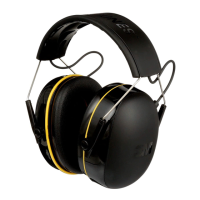
